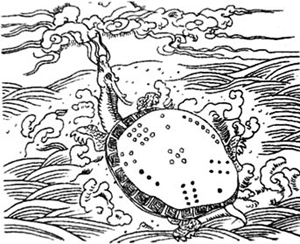Historical background of chronoacupuncture
- Fu Xi (the heavenly souvereign), one of China's first emperors, born in 29th century BC, is credited for the discovery of the Ba Gua (Eight Symbols).
One day sitting at the bank of Yellow river he saw a Qi Lin (mythological horse) rising from the water carrying a magical square He Tu (River Map) on his back.
The early emperor Yu tells a similar story of a magic turtle
rising from the Lo River carrying the Lo Shu pattern on his shell representing the numbers 1 to 9 in a magical square.
- The oldest Chinese farmer's calendar Wong Li dates back from the Xia dynasty
(2205-1766 BC) his calendar first divides a year in seasons and days.
- Evidence of the first heavenly stem and earthly branch cycles were found as carvings on oracle bones at least in the 13th century BC.
- Later the farmer's calendar Wong Li was combined with the stem and branch cycle and gave birth to the Xia calendar, that is still used today. The original start day of this calendar (2677 BC) coincides with the beginning of the era of Huang Di (the Yellow Emperor), whose medical conversations were recorded by Qi Bo in the Huang Di Nei Jing (The Yellow Emperors Inner Canon)
- The importance of treatment of disease at different times was first mentioned in
Shang Han Lun (Treatise of Cold Damage disorders) written by Zhang Zhong Jing at the end of the Han dynasty (before 220 AD)
In this early medical writing much emphasis is laid on the correct treatment time.
- The first open-hourly system of point selection was developed in the 10th century.
- The word chronoacupuncture was first used in the Zi Wu Liu Zu (Midnight-Noon Eb-Flow), written by He Ruoyu and annotated by Yan Ming Guan in the 12th century.
- The Zi Wu Liu Zhu was saved from oblivion by Xu Feng in 1439. Based on the theories described in the Nan Jing (The Yellow Emperors Classic of Difficulties), he made some adaptions to the methods used for calculating open acupuncture points.
- In 1601 Jang Jizhou copies Xu Fengs work into the Compendium of Acupuncture, in which he describes the theory and practice of different methods of chrono-acupuncture in detail.


